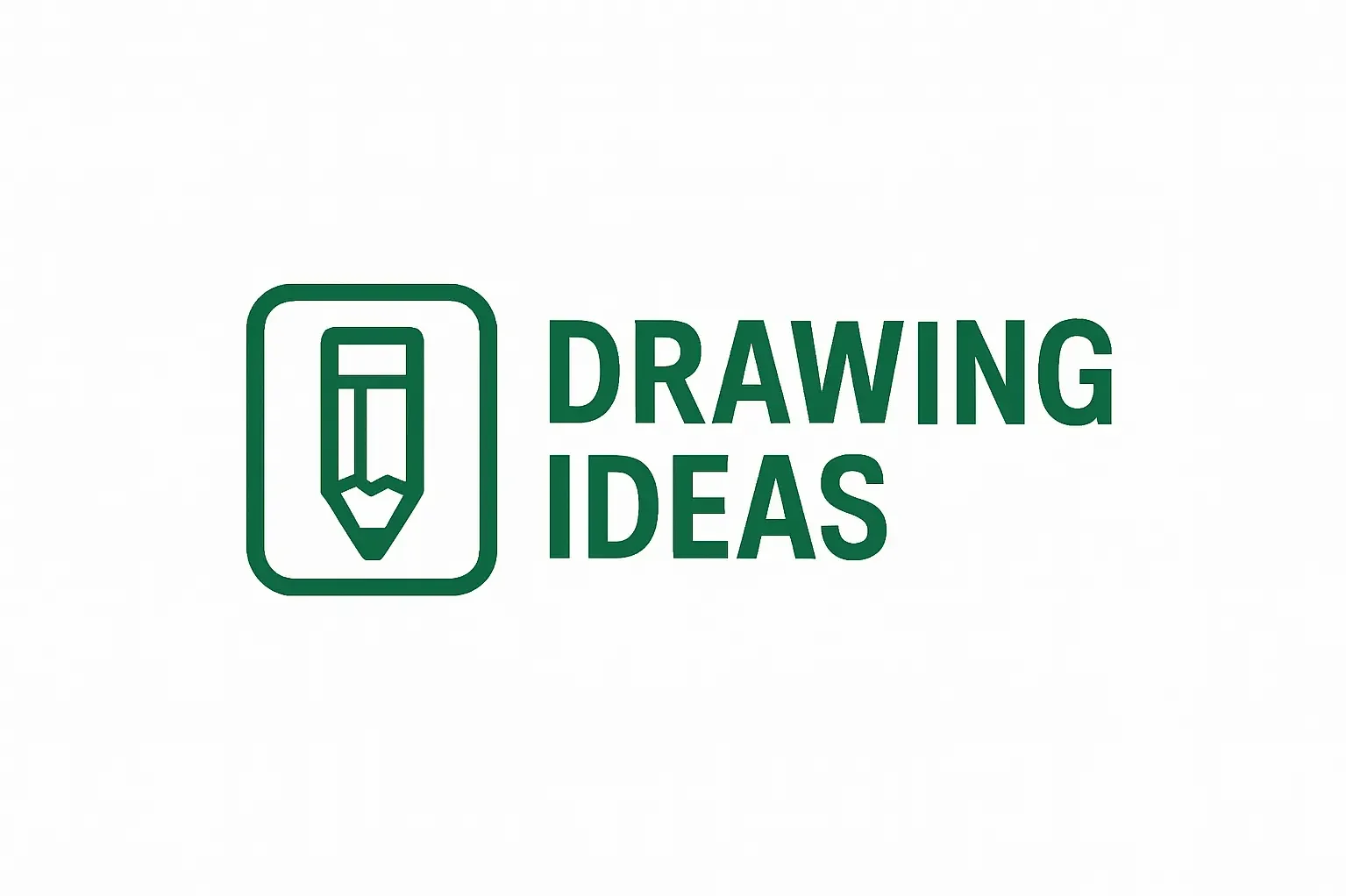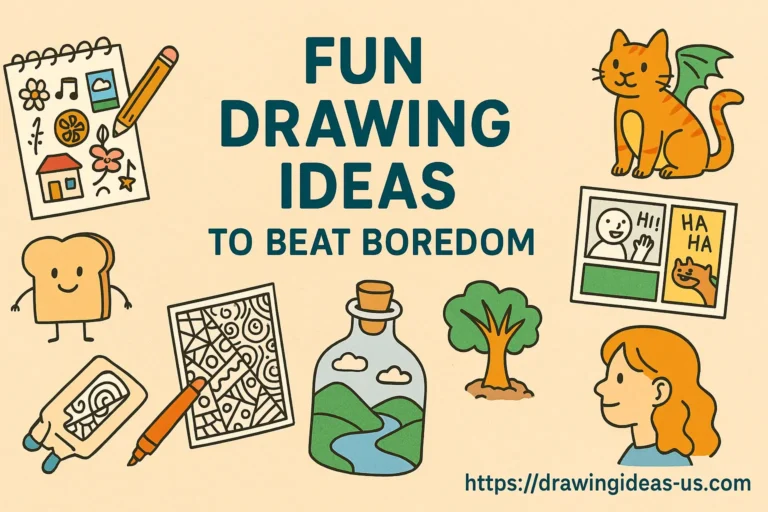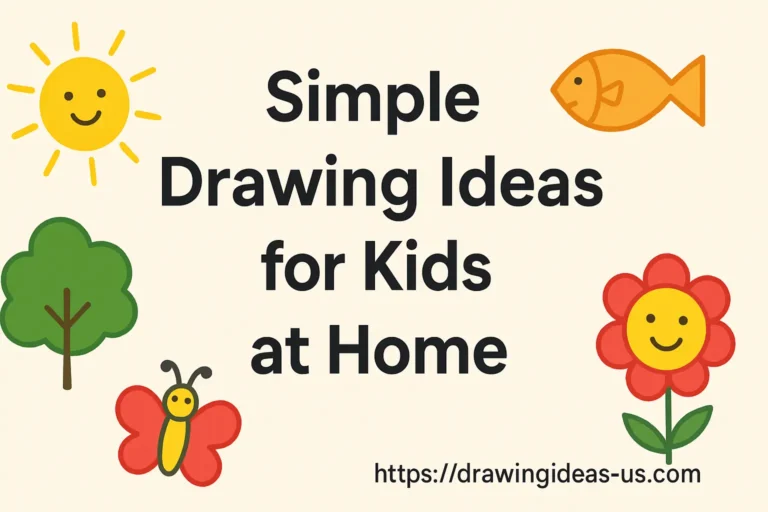Quick 5-Minute Drawing Ideas for Beginners
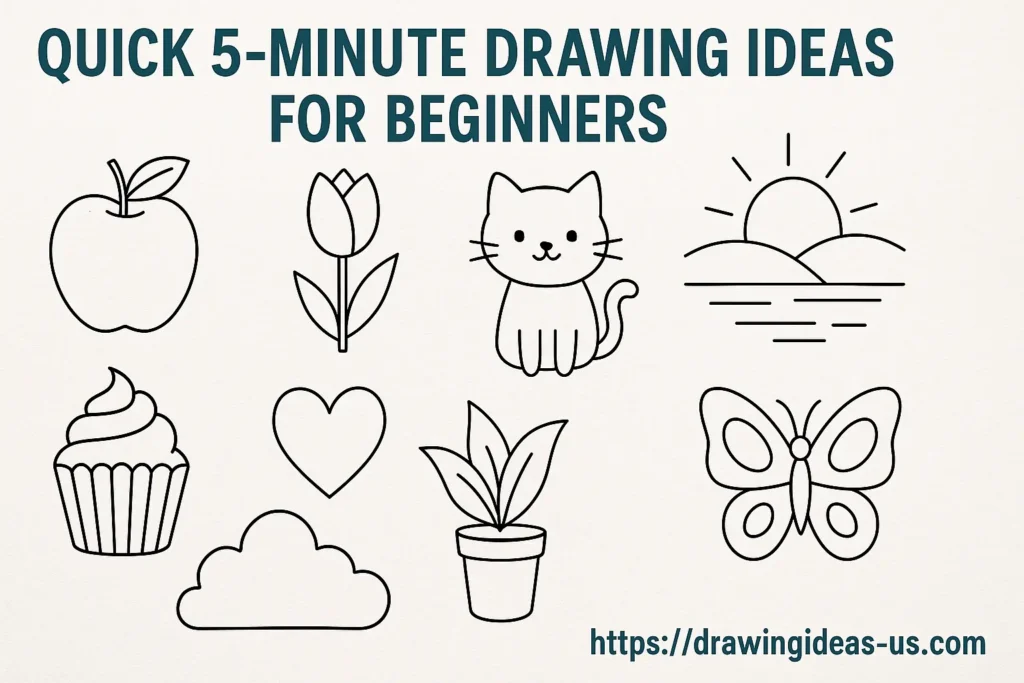
Introduction
Starting your artistic journey can feel overwhelming, especially if you believe that good art requires hours of practice. But the truth is, you can spark your creativity and build your skills in just a few minutes a day. With quick 5-minute drawing ideas, beginners can explore their creative side without pressure. These short sessions are perfect for developing consistency, learning techniques, and building confidence.
Whether you’re waiting for a friend, taking a break from work, or winding down in the evening, these ideas will help you practice and enjoy art in small, manageable chunks.
Why 5-Minute Drawings Work
When the goal is just five minutes, there’s no pressure for perfection. This mindset encourages freedom, creativity, and exploration.
Here’s why quick drawings are effective for beginners:
- They reduce the fear of making mistakes.
- They encourage experimentation with new techniques.
- They improve hand-eye coordination over time.
What You Need to Get Started
You don’t need fancy tools to begin drawing. Here’s a list of basic supplies to kick off your practice:
- Pencil or pen
- Sketchbook or plain paper
- Eraser (optional)
- Color pencils or markers (if desired)
Just grab whatever is available. The goal is not perfection, but practice.
Tips Before You Start Drawing
- Set a timer for 5 minutes. It keeps you focused.
- Don’t erase too much. Let your lines show growth.
- Draw quickly and confidently. Don’t overthink.
- Repeat drawings to see progress.
Quick 5-Minute Drawing Ideas for Beginners
1. Your Hand
Don’t worry about details—focus on getting the general shape and form.
Why it helps: Drawing your hand trains you to observe and replicate complex forms.
2. A Simple Leaf
Find a leaf outside or use your imagination. Focus on its shape, central vein, and texture.
Challenge: Add a few shading lines to show depth.
3. A Cup or Mug
Choose any cup from your kitchen and draw its shape, handle, and shadow. Try it from different angles in future sessions.
Improvement skill: Perspective and proportions.
4. Fruit (Apple, Banana, Orange)
Fruit is perfect for drawing because of its basic shapes. Practice light and shadow to give it a 3D effect.
5. Clouds
Draw a few fluffy clouds using circular and curved lines. Don’t stress about perfection—clouds are irregular by nature.
Great for: Learning soft shapes and freehand movement.
6. Your Footwear
Place your shoe in front of you and sketch its outline. Try adding laces or patterns.
Skill gained: Observation and pattern drawing.
7. A Smiling Face
Draw a simple face with big eyes and a smile. Add eyebrows, ears, or hair if time allows.
Good for: Expressing emotion through line art.
8. A Tree Silhouette
Draw a quick tree with a trunk and branches. Skip the leaves for speed.
Advance Tip: Use small line strokes for bark texture.
9. Your Favorite Snack
Sketch a cookie, candy bar, or fruit. Focus on shape and wrapping (if any).
Practice benefit: Drawing objects you enjoy increases motivation.
10. A Cat or Dog Face
Simplify an animal face into circles and triangles. Ears, nose, and whiskers can be stylized.
Good for: Learning symmetry and basic animal anatomy.
Creative Drawing Prompts
To make 5-minute sessions fun, try these creative prompts:
11. A House from Memory
Can you draw a house from your childhood memory in just five minutes? Include the roof, door, and maybe a window.
12. An Imaginary Creature
Let your imagination run wild. Combine parts of animals, or create your own species.
13. Doodle Your Mood
Are you happy, tired, or excited? Express that emotion using shapes or a simple face.
14. A Mini Landscape
Mountains, a river, and a tree. Keep it simple, but try adding depth with perspective.
15. What’s on Your Desk
Look around you and draw one item on your desk—maybe a pencil, phone, or notebook.
Themed Drawing Sessions
Try dedicating one 5-minute session each day to a specific theme. Here are some weekly themes to try:
- Monday: Nature (leaves, flowers, trees)
- Tuesday: Household Items (cup, spoon, scissors)
- Wednesday: Faces (emotions, eyes, lips)
- Thursday: Food (snacks, fruits, veggies)
- Friday: Animals (real or imaginary)
- Saturday: Patterns (zigzags, dots, spirals)
- Sunday: Free Draw (whatever you want!)
Use of Shapes for Quick Drawing
Most objects can be broken down into basic shapes—circles, squares, triangles, and rectangles. For example:
- A cat’s face = circle + triangle ears
- A car = a rectangular body + circles for wheels
- A flower = circle center + oval petals
Mastering these combinations helps beginners draw faster and more confidently.
Warm-Up Exercises Before Drawing
Just like stretching before a workout, warm-up sketching prepares your hand and mind.
Here are 2-minute warm-up ideas before your 5-minute drawing:
- Draw straight lines across the page
- Sketch spirals or loops
- Fill a space with small circles
- Practice shading from light to dark
Common Mistakes Beginners Make (and How to Avoid Them)
1. Aiming for Perfection
Quick sketches are about learning, not producing a masterpiece. Focus on enjoying the process.
2. Overusing the Eraser
Avoid spending more time erasing than drawing. Use mistakes as learning points.
3. Not Drawing Daily
Even 5 minutes daily builds skills faster than 2 hours once a month.
4. Comparing to Others
Every artist starts somewhere. Compare your progress only to your past self.
How to Stay Consistent with Daily Drawing
- Keep your sketchbook visible. This reminds you to draw.
- Use a timer. A 5-minute limit makes the task less intimidating.
- Track your progress. Mark days on a calendar when you complete a sketch.
- Join a drawing challenge. You can follow prompt lists or invent your own.
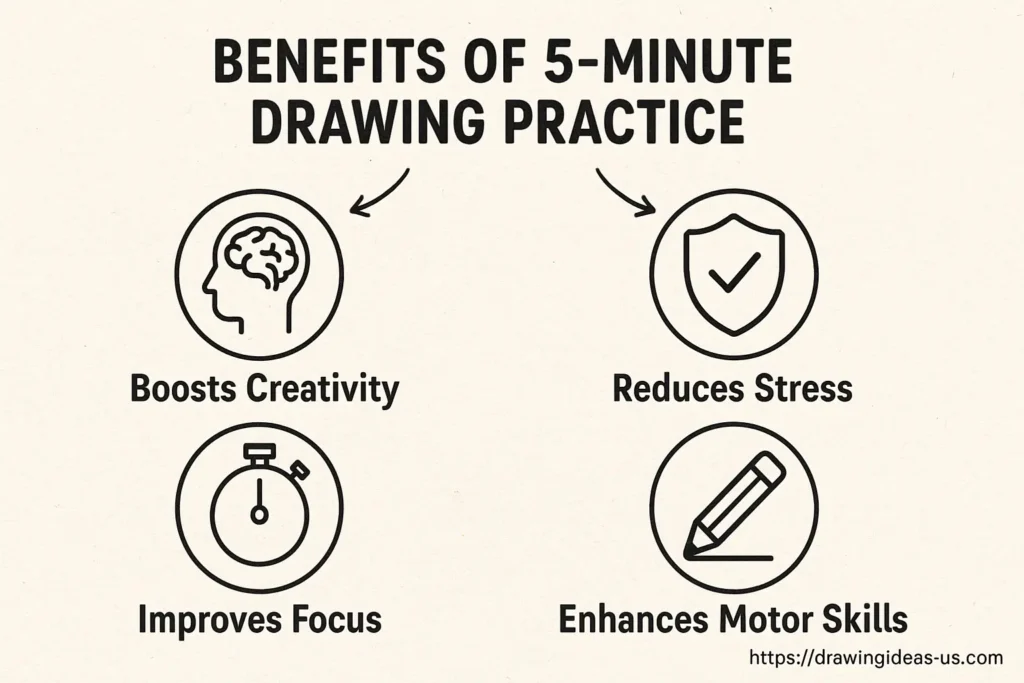
Benefits of 5-Minute Drawing Practice
Besides improving your art skills, daily drawing offers other advantages:
- Relieves stress
- Improves focus and mindfulness
- Boosts creativity
- Encourages visual thinking
- Develops observation skills
What to Do With Your Sketches
Don’t throw away your drawings. Use them in these ways:
- Create a “Before and After” comparison each month
- Decorate your journal or planner
- Share your progress with friends
Frequently Asked Questions (FAQs)
1. Can you really improve drawing skills in just 5 minutes a day?
Yes, short and consistent practice can significantly improve your drawing skills over time.
2. What are some good drawing tools for 5-minute sketches?
You only need basic supplies like a pencil, pen, eraser, and plain paper. A small sketchbook or notepad is also helpful for daily practice.
3. What should I draw if I feel stuck or uninspired?
Try drawing everyday objects around you, such as your keys, phone, or coffee cup. You can also use quick prompts like a smiling face, a tree, or a simple fruit.
4. Are 5-minute drawing ideas suitable for complete beginners?
Absolutely. The goal is to keep things simple and focus on regular practice instead of perfect results.
5. Should I time myself while doing these sketches?
Yes, setting a 5-minute timer helps keep your practice focused and stress-free.
6. How do I know if I’m improving with quick sketches?
Track your drawings daily or weekly. Look back after a month and compare. You’ll often see better line control, proportions, and creativity.
7. Can kids use these 5-minute drawing ideas too?
Yes, these ideas are great for children as well. They’re simple and engaging and help develop fine motor skills and creativity in a fun way.
8. What if I want to spend more than five minutes drawing?
That’s great! These ideas can be extended. Start with a 5-minute sketch, and if you have more time, refine or color it to practice more skills.
9. How often should I draw to see results?
Drawing for five minutes daily is better than drawing once a week for an hour.
10. Do I need to follow tutorials or take art classes to begin?
Not necessarily. While tutorials can help, simple daily sketches based on observation and creativity are enough to build strong foundational skills.
Final Thoughts
Beginners often feel the need to produce perfect art, but these quick sessions prove that creativity can thrive in short bursts.
Start small, stay relaxed, and remember—every great artist once started with a single line. Whether you’re doodling a tree, a coffee cup, or an imaginary monster, you’re developing skills that will build your artistic confidence day by day.
